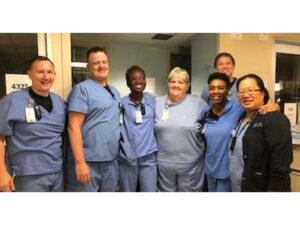Global Health Experts Go Local to Create Safe Spaces Amid COVID-19
December 17, 2020
Institute for Global Health and Infectious Diseases

Some of UNC’s MICU staff in the days before all-day personal protective equipment.
A collaborative team, drawing in part on experience working with disease outbreaks in Africa, has remarkably transformed UNC’s Medical Intensive Care Unit to treat COVID-19 patients. They’ve demonstrated that it’s possible to provide critical care for patients while keeping providers safe.
Like most of us during the pandemic, Billy Fischer, MD, has stayed put the last few months, leaving home mainly just to report to work at UNC Health’s Medical Intensive Care Unit.
“It’s the longest I’ve been home in a while,” says Fischer, who is accustomed to traveling the globe as a critical care pulmonologist and emerging pathogens director for UNC’s Institute for Global Health and Infectious Diseases.
The pandemic may have grounded much of Fischer’s travel, but he has hardly paused his work. He is helping to lead two large-scale COVID-19 research studies while also treating COVID patients in the Medical Intensive Care Unit, or MICU. There he works alongside a resilient team including a core group of advanced practice providers, MICU nurses, environmental services staff, pharmacists, and many others. “Without Kai, Honey, Amy, and Q, our pharmacy team, Victor and Marta on the environmental services team, we would not be able to provide the type of care that we expect at UNC,” Fischer says. “The ICU is such a complicated treatment space that requires a multi-dimensional team. I am really lucky to be a part of this one.”
Early on, during “incredibly scary” times, Fischer and the MICU team needed to design a treatment space that would provide patients and health care providers with the highest level of protection possible from a contagious disease that was still largely unknown. But the space had to also allow the team to provide the same high-level critical supportive care – a complicated task for space that was not designed for management of patients with high consequence pathogens.
A Chapel Hill hospital may be worlds away from a healthcare facility in West or Central Africa, but Fischer’s view of how to adapt the MICU space was modeled after the tents and C.U.B.Es where he treated Ebola patients in Guinea, Liberia, and Democratic Republic of Congo from 2014 through 2019.
“I learned from Ebola that in order to effectively navigate the uncertainty that surrounds these deadly diseases, you need to provide structure for the provider and the patient,” he says. “Everyone has to wear the same personal protective equipment every day, and you get dressed the same way every day, in exactly the same order. You come in only through one door and you leave out of only one door, which is different from the entrance. Your exit is guided by someone whose sole responsibility is to get you out of your contaminated PPE safely. The key is to replace the uncertainty about the disease with a set of rules that keep the provider safe and allows them to be effective.”
The MICU was never designed for such a transformation, so it required a collaborative team of nurses, physicians, infection control experts, and engineers to think together about how to adapt the space. Led by Loc Culp, the nurse manager for the MICU, and Shannon Carson, UNC’s chief of pulmonary disease and critical care, Lisa Teal, Emily Sickbert Bennet from Infection Control, and colleagues from infectious diseases, environmental services, and engineering, a COVID-ICU was established to provide a safe place to care for critically ill patients with COVID-19.
UNC Health’s MICU has had no transmissions of the virus as a result of all the structure and repetition. “We’ve transformed what it means to provide care during an outbreak, or in this case critical care during a pandemic, and we’ve demonstrated that we can do it safely,” Fischer says. “But key to this effort is not just drawing a line separating high- and low-risk areas but it requires establishing a culture of security and infection control that has been led by Kai, Honey, Amy, Q and the MICU nurses. It’s this culture that keeps us safe and the patients cared for. Without them, we’re lost.”
Read about Loc Culp;s days in the MICU during COVID-19
The design of the MICU is intentional, fitting into an overall UNC Health strategy designed to identify infected individuals in collaboration with providers around the system. “We’re working with the amazing McClendon Lab team led by Melissa Miller to get people into care as quickly and safely as possible,” Fischer says.
As the numbers of COVID-19 patients climb in North Carolina and at UNC, “creating a safe space and a safe culture are essential not only to care for patients with COVID-19,” he says, “but also to ensure that essential non-COVID healthcare delivery continues at UNC.”
